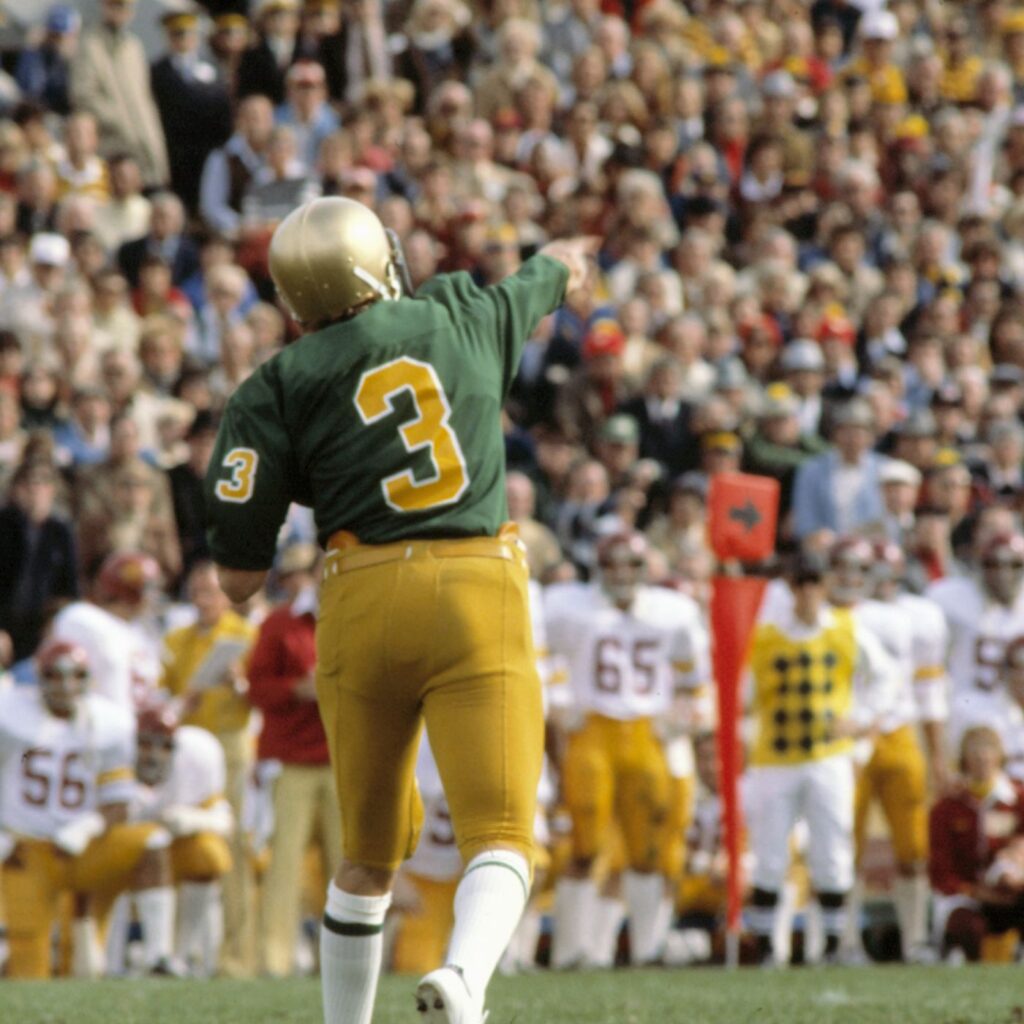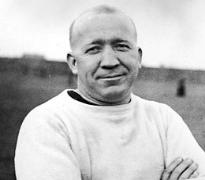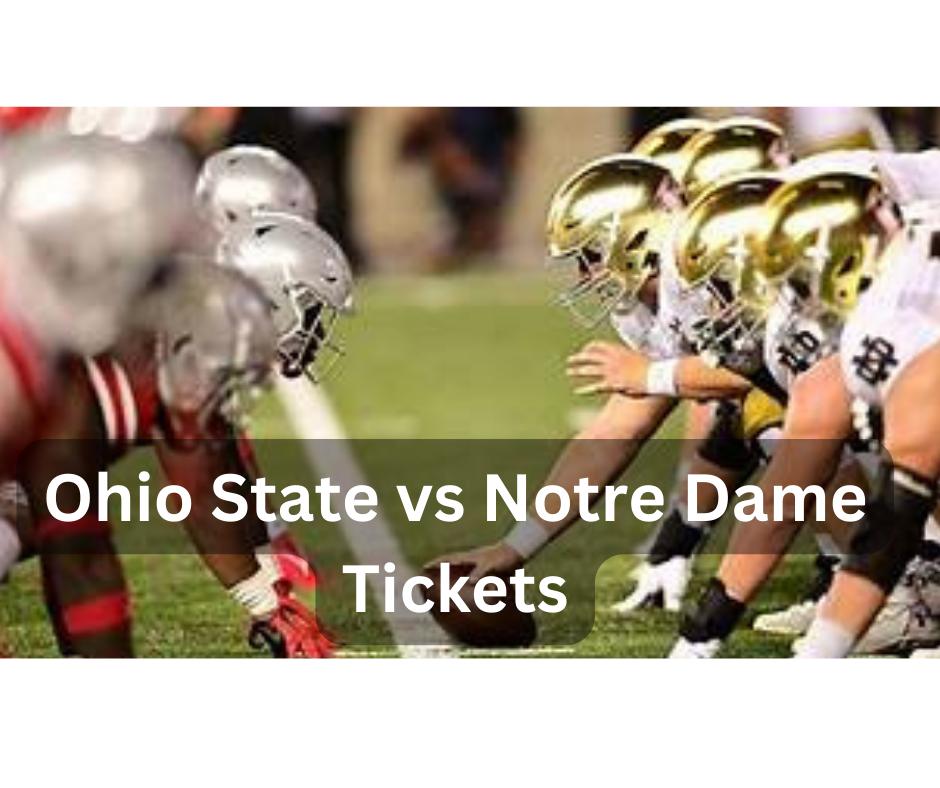When you think of great college traditions, look no further than the University of Notre Dame. Along with winning a slew of national championships and producing many of football’s greatest legends, the university has an incredible nickname, mascot and an incredible lineup of traditions that are second to none.
The Origins of the Fighting Irish Nickname
The Fighting Irish nickname is synonymous with Notre Dame football, yet that nickname was not officially recognized by the university until 1927, 40 years after Notre Dame lost its first football game in school history, 8-0 to Michigan on Nov. 23, 1887.
The first nickname for the Notre Dame football team was appropriately the “Catholics,” a moniker that gave way briefly to the “Ramblers” during the days of the Four Horsemen in the early 1920s before “Fighting Irish” took over for good.

Football players honor the student section with the raising of their helmets after each game.
As for the origin of the Irish nickname, no one seems to know for certain from where it came. But there are several possible explanations. Northwestern University fans may deserve some of the credit. In an Oct. 27, 1899 game in Evanston, Ill., Notre Dame took a 5-0 halftime lead over Northwestern. As the second half got underway, the home team fans began to chant “Kill the Fighting Irish, kill the Fighting Irish.” Notre Dame won 12-0.
Ten years later, at halftime of a game at Michigan, when one Notre Dame player challenged his teammates with names like Dolan, Kelly, Duffy and Ryan with comments such as “What’s the matter with you guys? You’re all Irish and you’re not fighting worth a lick.” After Notre Dame pulled out an 11-3 victory, some reporters wrote about a victory for the “Fighting Irish” after hearing about the halftime pep talk.
The Rev. Matthew Walsh, then the president of the university, official adopted the Fighting Irish nickname in 1927, after the term had become commonplace in New York Daily News columns written by Notre Dame alumnus Francis Wallace in the 1920s.
According to Notre Dame publications, the most generally accepted explanation is that’ ‘the press coined the nickname as a characterization of Notre Dame athletic teams, their never-say-die fighting spirit and their Irish qualities of grit, determination and tenacity.”

Best Gifts For Notre Dame Fans
Discover our section dedicated to great gift options for the Notre Dame fan on your shopping list. Jerseys, shirts, caps and flags are high on the list, but don’t pass on autographed collectibles.
Notre Dame Mascot: The Leprechaun

Have you ever wondered your lucky charms off by
wondering whom that little green-dressed fella is that hangs out with Notre Dame’s cheerleaders? He’s known as the Notre Dame Leprechaun and serves as the Fighting Irish’s number one fan.
Since the mythical Leprechaun exhibits shyness and an ability to hide, there are many people who have little knowledge of what one is.
The Merriam-Webster Dictionary defines a leprechaun as a mischievous elf of Irish folklore.
Before the Notre Dame Leprechaun can take the field to cheer for the Irish, he must compete against other mascot hopefuls seeking to make their competitors green with envy. Candidates complete a week-long training period where they learn Leprechaun responsibilities.
Once the formal tryout is held, candidates participate in a formal interview process with the board of judges that includes university administration, coaches and alumni association members. Questions range from academic aptitude to why the individual wants to be the Leprechaun.
Once all questions are answered, the candidates jump into the Leprechaun uniform for the pep rally portion of the judging. After delivering a spirited speech to the crowd, the
competing students must stand tall against a series of tough questions generated by area media members.
The final phase places the candidates in a game situation where they are given a scenario and are judged on how they respond.
Despite the small stature of the typical Notre Dame Leprechaun, the mascot stands tall as a symbol for the school. “It’s truly an honor and I’m humbled to be able to represent the university,” said 1998 football Leprechaun Matthew Bozzelli.
“It’s been an absolute joy to represent such a wonderful family and to see in the faces of our alumni and fans what the Notre Dame spirit means to them. To me I’m the personification of that spirit and it’s an honor.”
Notre Dame Gamedays are ‘Guarded’
This kilt-wearing squad is a key component of Notre Dame’s band. Each member of the guard stands more than eight feet tall when donning their bearskin shako.
The all-male team is selected based on their individual marching ability, appearance and spirit.
Besides performing an Irish dance at halftime, the group participates in other game day activities. “We march in front of the band all the way to the stadium,” said Irish Guard member Rick Saxen during the 1998 Army game. “We form a buffer between the fans and the band to make sure nothing rowdy happens.”
A Notre Dame home victory sets up quite a celebration for the Irish Guard. “The victory clog is another tradition,” said Saxen. After every win the Irish Guard does a clog on the field after the game. It’s sort of a little dance.”


Green With Envy
Although the standard Notre Dame home jersey is dark blue with white numerals, gold outlining, and a small interlocking “ND” logo, it’s the tradition of the Kelly Green jerseys that has become legendary.
Coach Dan Devine first introduced the green jerseys during the 1977 season.
Leading up to a huge mid-season contest against USC, Devine sought a motivational tool to get his team fired up. While his green jersey idea was draped in secrecy, Coach Devine whipped up excitement the week before the game by introducing stories about how important green was to the Irish and Notre Dame tradition.
Devine’s Fighting Irish went through pregame warm ups in their customary blue jerseys. However when they returned to the locker room 10 minutes before the game their lockers were draped with the green jerseys. The ploy paid off as an emotional Notre Dame squad
destroyed USC 49 to 19. Notre Dame has worn green jerseys since for special occasions, but never with the tremendous success of the 1977 USC Game.
The use of Notre Dame green jerseys without an emotional reason took place decades before against Iowa. Notre Dame changed to green jerseys at halftime to help separate their dark jersey colors from Iowa’s.
The Golden Dome’s of Notre Dame
The top of the university’s administration building is the setting for this famous landmark. Dating back to the 19th century, the dome is surrounded by a statue of Our Lady. The Golden Dome’s elegance is symbolized by the gold football helmets worn by the Irish. Before each game, the helmets are painted with a special mixture that includes the same gold dust that’s bought on behalf of the golden dome from the 0 ‘Brien Paint Company.


helmets in their honor. Former Notre Dame Leprechaun Brian Stark says he helped to initiate the tradition in 1987.
“The meaning behind it is one that you have to know Notre Dame to understand,” Stark explained. “Certainly all teams go over and salute their fans, although not all of them salute win or lose. But the more important symbol here at the university, truthfully, is that the golden helmets which are painted with 24-carat gold, the same type of gold that’s lacquered on the golden dome.
It’s our reminder that we’re all here because of Notre Dame, our Mother, who is the blessed Mother on top of the Dome. And so raising the helmets is a sign that our football endeavors are actually part of a bigger and much more important meaning here at Notre Dame.”

The Legendary Fighting Irish Coaches
Knute Rockne
The most successful coach in college football history almost never had a football career. His parents forbid him from playing football when, as a youth growing up in Chicago, he came home from a sandlot game after having been used as a human punching bag.
Knute Rockne fmally returned to football, with the blessing of his parents, while in high school. After high school, Rockne worked as a mail dispatcher in Chicago for four years, before finally saving enough money to get on a train and head to South Bend, Ind., to pursue his college education.
Rockne played varsity football his first season, but after a tough season, he concentrated on track. He returned to football after success in track, and earned All-American honors during his senior season (1913), when he also served captain.
His coaching career began as an assistant to Jesse Harper. Rockne accepted a position as a graduate assistant in chemistry at Notre Dame, with the condition that he be allowed to be an assistant football coach. Harper resigned in 1917, and Rockne began building Notre Dame into a national power.

In Rockne’s 13 seasons, Notre Dame had five unbeaten and untied season while compiling a 105-12-5 record (.881 winning percentage). Rockne also served as Notre Dame’s athletic director, business manager, ticket manager, track coach and equipment manager. He wrote a weekly newspaper column, wrote three books and was the principle designer of Notre Dame Stadium. In March 1931,just months after a championship season, Rockne was killed in a plane crash.
FRANK LEAHY
If Knute Rockne is credited with helping Notre Dame first part college football’s Red Sea, then Frank Lehay should be honored for leading the Irish to the promised land. Long before he took the Irish’s coaching reins, Lehay was a tackle (1928-30) on Rockne’s last three Notre Dame teams.
Lehay’s first stint as the Irish coach followed two successful years at Boston College where he guided the Eagles to a 20-2 record and a Sugar Bowl victory. His first season in South Bend was 1941 and two years later he coached his first national championship team.
The Four Horsemen of Notre Dame

In the 30 games that they played together over three
seasons, the Four Horsemen none more than six
feet tall and 162 pounds led Notre Dame to a 27-2-1
record from 1922-24, both of the losses to
Nebraska. Their senior season, 1924, Notre Dame
was 10-0 , beating Stanford 27-10 in the 1925 Rose
Bowl for the national championship.
All four players are members of the National
Football Foundation Hall of Fame. The Four
Horsemen nickname grew from a October 1924
article written by famed sports writer Grantland Rice.
He coined the phrase while writing about the Notre
Dame backfield after its third straight victory over
Army.
The following week, a publicity aide at Notre Dame
posed the four players, dressed in uniforms, on the
backs of four horses. The result was a photograph
that only helped to elevate their lore in college
football history.

The Legend of George Gipp and “Winning one for the Gipper”
George Gipp was Notre Dame’s first All-American who played for Coach Knute Rockne. The Irish star died from a strep throat infection just a few days after leading his team to a win over Northwestern his senior season. While on his deathbed in 1920, legend has it that
Gipp told Coach Rockne, “I’ve got to go, rock. It’s all right. I’m not afraid. Some time, Rock, when the team is up against it, when the breaks are beating the boys, ask them to go in there with all they’ve got and win just one for the Gipper.
I don’t know where I’ll be then, Rock. But I’ll know about it and i’ll be happy.”
Rockne later used Gipp’s last words to inspire his team to rally against an undefeated Army team. The underdog Irish responded with a 12-6 victory in that 1928 game. Ronald Reagan starred as George Gipp in the 1940 movie, Knute Rockne, All-American. Following that role, Reagen was often referred to as “The Gipper” following the movie’s release and he used the “Win one the Gipper” phrase successfully in politics all the way to the White House.
Discover more amazing Notre Dame Facts in the Sections Below
Notre Dame vs Ohio State Tickets, Series and Gameday Information
Get tickets for the Notre Dame – Ohio State game scheduled for Sept. 23, 2023 in South Bend. Along…
10 Best Gifts For a Notre Dame Fan
Are you looking for the perfect present to give your favorite Notre Dame fan? Shopping can be a challenge when…
Notre Dame NFL MVPs and AFL MVPs
Notre Dame, a storied college football program, has not only produced some of the sport’s greatest players but has also…


